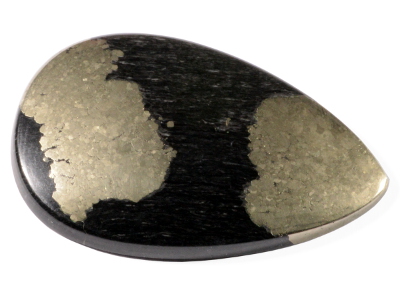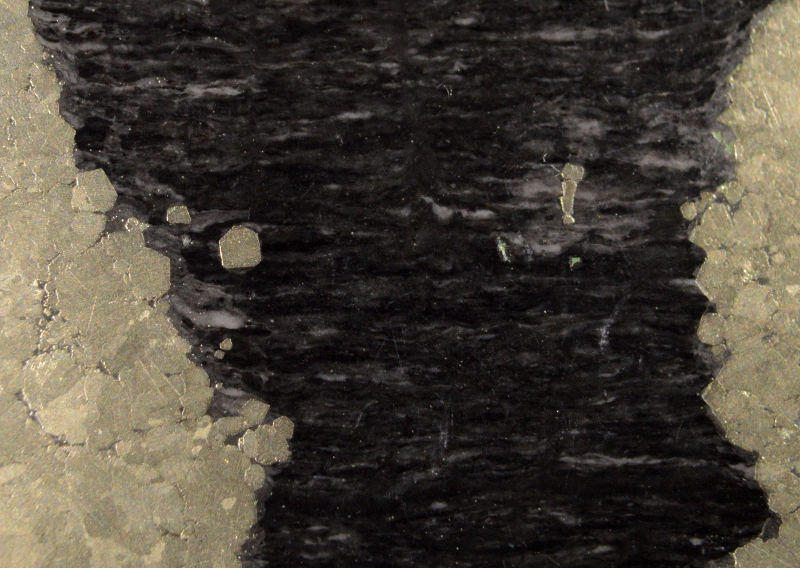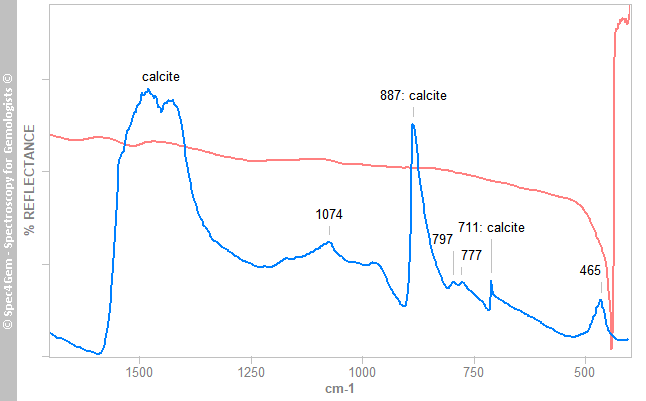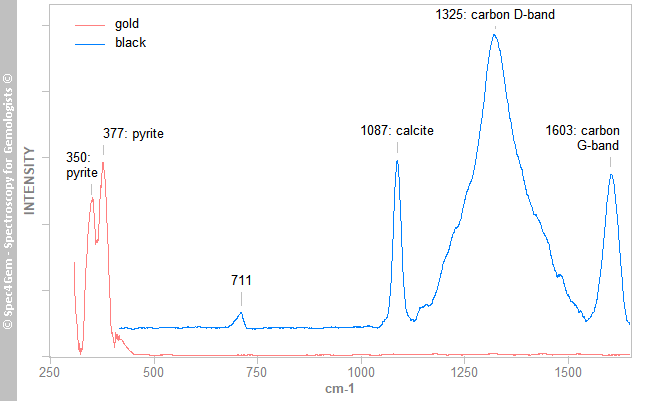Apache gold - A black and shiny gold cabochon from Jerome, Arizona, USA
- Details
- Created: Monday, 01 April 2024 21:45
Apache Gold is the trade name given to an elegant black and shiny metallic gold rock found in the United Verde Mine in Jerome, Arizona, USA. The black host rock is reported to be a chlorite schist and the shiny gold material to be chalcopyrite (CuFeS2) also sometimes known as fool's gold and is a high grade copper ore. The name Apache Gold is a reference to the Apache Indians who lived in Arizona and the gold color of the Chalcopyrite.
The mine was close down since 1953 and it is located high on top of the Cleopatra hill (1585 m) in the Black Hills (Black Hill Range), between Prescott and Flagstaff, in the mining town of Jerome, Yavapai County, Arizona, USA. These mountains got their name from their dark cap of basalt. The rich copper sulfides were accumulated in volcanic materials and hydrothermal activity metamorphosed the all into black graphite and chlorite schists.
Chalcopyrite is a copper and iron sulfide that looks similar to golden pyrite (iron sulfide) but it has a richer, more buttery yellow color and is used as copper ore.
The sample of this Apache Gold material, described in this page, is shown in Figure 1 and a closer view is shown in Figure 2.
 Figure 1. An Apache Gold cabochon of 40.62 ct showing two gold
Figure 1. An Apache Gold cabochon of 40.62 ct showing two goldcolor area, aggregates of cristals lying into a black schisteous rock.
| Shape | pear cabochon |
| Size | 38 x 24 mm |
| Color | black and bright gold color |
| Diaphaneity | opaque |
| Lustre | dull (black), shiny, metallic (gold colored) |
| Weight | 40.62 ct |
| SG | 3.48 indicative but logically depends on the proportion of the gold and black materials |
| RI | - |
| DR | - |
| Pleochroism | - |
| Polariscope / Conoscope | - |
| SWUV | - |
| LWUV | - |
| Magnetic susceptibility N52 | very slightly attracted |
| Chelsea filter | - |
Table 1. Observational and measured properties

Figure 2. Close view (~15 x 11 mm) showing the details of the two materials. The black one is in fact an alternating of thin black and gray layers,
hence the schisteous structure. The light golden material appears like a crystals aggregate, some suggest a cubic symetry.
Infrared reflectance spectroscopy:
Few FTIR spectra in reflectance mode were collected from the gold and black area, the best ones for each area are shown in Figure 3. The gold area spectrum clearly shows a pyrite spectrum and not that of chalcopyrite because the strong reflectance between 400 and 430 cm-1 followed by a dramatic fall arround 440 cm-1 does not exist in chalcopyrite. The black area spectrum is a composite spectrum that is dominated by the calcite carbonate with the characteristic reflectance bands at 711 and 887 cm-1 and the 1350 to 1600 cm-1 features. Secondary bands in the spectrum can be observed at 465, 777, 797, ~975, 1074 and 1170 cm-1. The 465 cm-1, the 777 and 797 cm-1 'doublet' and the wide reflectance bands between 950 and 1200 cm-1 can possibly be attributed to a microcrystaline quartz (jasper). The ~975, 1074 and 1170 cm-1 are not yet explained, they do not exactly match nor the carbon in graphite or charcoal nor the minerals of the chlorite group. More investigations have to be performed.
 Figure 2. IR reflectance spectra of the gold and black area of the cabochon. Gold area yields a characteristic pyrite spectrum (red) and the black area yields a spectrum (black) dominated by calcite, however all reflectance bands are not yet assigned, with possible quartz at 465, 777 and 797 cm-1.
Figure 2. IR reflectance spectra of the gold and black area of the cabochon. Gold area yields a characteristic pyrite spectrum (red) and the black area yields a spectrum (black) dominated by calcite, however all reflectance bands are not yet assigned, with possible quartz at 465, 777 and 797 cm-1. Raman spectroscopy:
As for FTIR, Raman spectra were collected from distinct spots in both gold and black area, the most significant ones are shown in Figure 4. Here again the pyrite is confirmed with its two peaks at 350 and 377 cm-1 although chalcopyrite has peaks at 291, 319 and 352 cm-1. Getting the Raman spectra of the black area was also difficult (opaque black material) but the spectrum shows nevertheless the calcite spectrum with two peaks at 711 and 1087 cm-1. The rest of the spectrum shows an uncomon peak at 1325 cm-1 with a broad base and then a more conventionnal shaped peak at 1603 cm-1. The 1325 and 1603 cm-1 peaks are those of the carbon, respectively the Disordered and the Graphitic bands (Brolly et al. 2015)[1].
 Figure 3. Raman spectra of the gold area (red) and the black area (blue). The gold area spectra yields a pyrite spectrum and the black area and the black area shows calcite (711 and 1087 cm-1), carbon (1325 and 1603 cm-1).
Figure 3. Raman spectra of the gold area (red) and the black area (blue). The gold area spectra yields a pyrite spectrum and the black area and the black area shows calcite (711 and 1087 cm-1), carbon (1325 and 1603 cm-1).UV-VIS-NIR spectroscopy:
Gold and black materials are opaque, no UV-VIS-NIR spectroscopy performed.
Photoluminescence spectroscopy:
No photoluminescence observed with the classical sources (254, 370, 405 nm).
Conclusion:
An attractive cabochon by its colors and luster, here constituted of pyrite (not chalcopyrite as generally described) and a black schist with carbon giving its color and calcite, possibly quartz and haematite. It likely contains other minerals, going further in determination would require more investigations to search for the chlorite group minerals supposed to belong to a chlorite schist.
It exists in the market a similar material with the same trade name where the 'gold' material is not blocky as in our sample but more evently distributed in the rock as smaller particles that gives another rendering.

